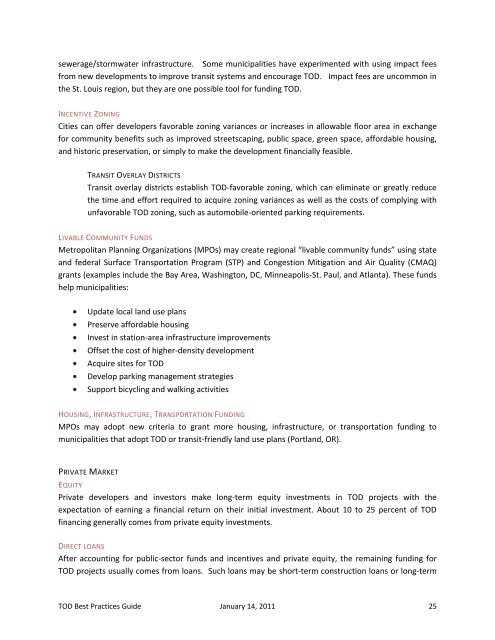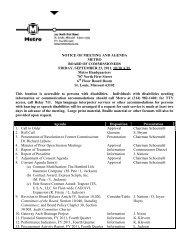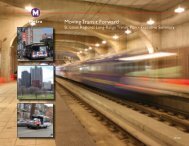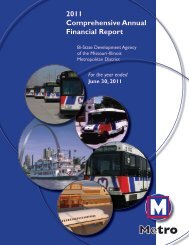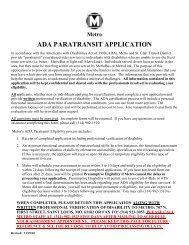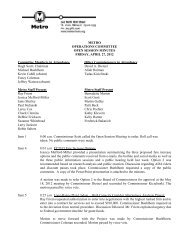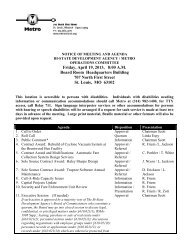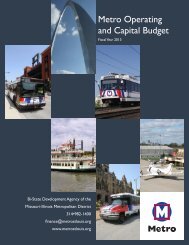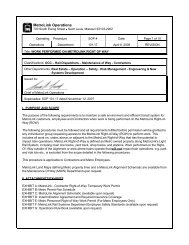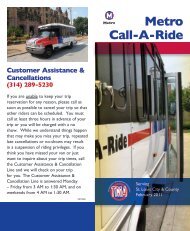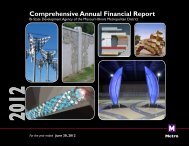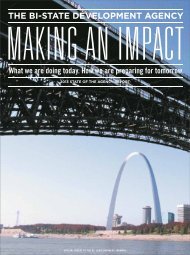st.louis regional transit -oriented development best ... - Metro Transit
st.louis regional transit -oriented development best ... - Metro Transit
st.louis regional transit -oriented development best ... - Metro Transit
You also want an ePaper? Increase the reach of your titles
YUMPU automatically turns print PDFs into web optimized ePapers that Google loves.
sewerage/<strong>st</strong>ormwater infra<strong>st</strong>ructure. Some municipalities have experimented with using impact fees<br />
from new <strong>development</strong>s to improve <strong>transit</strong> sy<strong>st</strong>ems and encourage TOD. Impact fees are uncommon in<br />
the St. Louis region, but they are one possible tool for funding TOD.<br />
INCENTIVE ZONING<br />
Cities can offer developers favorable zoning variances or increases in allowable floor area in exchange<br />
for community benefits such as improved <strong>st</strong>reetscaping, public space, green space, affordable housing,<br />
and hi<strong>st</strong>oric preservation, or simply to make the <strong>development</strong> financially feasible.<br />
TRANSIT OVERLAY DISTRICTS<br />
<strong>Transit</strong> overlay di<strong>st</strong>ricts e<strong>st</strong>ablish TOD-favorable zoning, which can eliminate or greatly reduce<br />
the time and effort required to acquire zoning variances as well as the co<strong>st</strong>s of complying with<br />
unfavorable TOD zoning, such as automobile-<strong>oriented</strong> parking requirements.<br />
LIVABLE COMMUNITY FUNDS<br />
<strong>Metro</strong>politan Planning Organizations (MPOs) may create <strong>regional</strong> “livable community funds” using <strong>st</strong>ate<br />
and federal Surface Transportation Program (STP) and Conge<strong>st</strong>ion Mitigation and Air Quality (CMAQ)<br />
grants (examples include the Bay Area, Washington, DC, Minneapolis-St. Paul, and Atlanta). These funds<br />
help municipalities:<br />
Update local land use plans<br />
Preserve affordable housing<br />
Inve<strong>st</strong> in <strong>st</strong>ation-area infra<strong>st</strong>ructure improvements<br />
Offset the co<strong>st</strong> of higher-density <strong>development</strong><br />
Acquire sites for TOD<br />
Develop parking management <strong>st</strong>rategies<br />
Support bicycling and walking activities<br />
HOUSING, INFRASTRUCTURE, TRANSPORTATION FUNDING<br />
MPOs may adopt new criteria to grant more housing, infra<strong>st</strong>ructure, or transportation funding to<br />
municipalities that adopt TOD or <strong>transit</strong>-friendly land use plans (Portland, OR).<br />
PRIVATE MARKET<br />
EQUITY<br />
Private developers and inve<strong>st</strong>ors make long-term equity inve<strong>st</strong>ments in TOD projects with the<br />
expectation of earning a financial return on their initial inve<strong>st</strong>ment. About 10 to 25 percent of TOD<br />
financing generally comes from private equity inve<strong>st</strong>ments.<br />
DIRECT LOANS<br />
After accounting for public-sector funds and incentives and private equity, the remaining funding for<br />
TOD projects usually comes from loans. Such loans may be short-term con<strong>st</strong>ruction loans or long-term<br />
TOD Be<strong>st</strong> Practices Guide January 14, 2011 25


